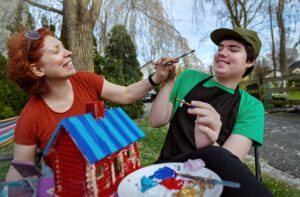Beyond Labels: Embracing Neurodiversity Through a Trauma-Informed Lens

18 July 2024
Allen Goold, Functional Family Therapy Clinical Manager, recalls consulting on a challenging case involving a high-personality second grader, *Eva, known for her disruptive outbursts in the classroom. During her fits of rage, Eva would throw books, topple chairs, and disrupt class activities.
Despite the chaos, Allen noticed that Eva exhibited remarkable self-control by ensuring she did not harm her teachers or peers during her episodes. He saw this as a clear sign of her positive intent to not hurt others and her desire to be accepted by her classmates.
“Understanding the full context of behavior is so much different than just seeing a fragment of the story,” said Allen, who believes in positioning clients as experts on their experience. “By creating an environment where individuals have a voice rather than passively receiving a service, we can figure out ways to move forward together.”
Initially, Eva entered treatment with an “alphabet soup” of diagnoses. However, following comprehensive psychological assessments and intensive therapeutic work, the team was able to narrow down her experience to ADHD – a type of neurodiversity – and a previously undiscovered brain injury from riding a roller coaster.
“That, combined with her early trauma history from being adopted, created what we saw in the classroom,” said Allen.
Allen’s experience demonstrates how a trauma-informed approach helps clinicians understand neurodiversity through a wider lens, which includes clients’ reactions to traumatic experiences.
 While definitions vary, neurodiversity refers to the natural variations in the human brain, encompassing differences in how we think, process, learn, and behave. Many of us understand neurodiversity by the diagnoses or labels given to individuals with neurodivergent characteristics, including autism, ADHD, and dyslexia.
While definitions vary, neurodiversity refers to the natural variations in the human brain, encompassing differences in how we think, process, learn, and behave. Many of us understand neurodiversity by the diagnoses or labels given to individuals with neurodivergent characteristics, including autism, ADHD, and dyslexia.
Although trauma is not typically classified as a type of neurodivergence, it fits the definition as it can impact brain function over time. Research has demonstrated that trauma, especially in childhood, can significantly impact brain development.
“If you think about a child who has experienced prolonged or intense short-term trauma, their brain is flooded with trauma-response neurochemicals that impact how the brain grows,” said Allen. “They have to learn life lessons on how to manage these trauma responses.”
Functional Family Therapy uses the concept of matching in working with youth and families. Matching means accommodating to the strengths and needs of an individual or family, which includes neurodivergent experiences that a person may have. It involves meeting a person or family where they are, being open to learning about their experiences, and being flexible about changes that may be needed.
For example, a therapist working with a person with ADHD may need to incorporate activities or breaks into sessions, limit session duration, and educate other family members to accommodate their unique needs.
“The assumption is that if something’s not working, what can be done to shift things to make it better?” said Allen. “It’s important to create a place where differences can not only be discussed but celebrated.”
When applying a diagnosis or label to someone’s unique experience of neurodiversity, clinicians like Allen understand that a diagnosis can feel stigmatizing and make neurodiversity seem like a deficiency.
“The initial way we began to talk about a person’s neurodiverse experiences is to classify them as a disorder,” said Allen. “Over time, we’ve gotten better at understanding that it’s just a broad spectrum of human experience. Although we have these labels, it’s extremely important to remember that each person’s experience of ADHD, autism, or dyslexia, for example, is nuanced and different. A diagnosis is simply a way to communicate about an aspect of someone’s experience – it is not a definition of who they are as a person.”
However, it’s also true that some neurodivergent individuals may have disabilities or impairments that require specialized support.
“There are kiddos who can benefit from a disability diagnosis as it can assist the family in receiving needed assistance and benefits,” said Angela Hiland, a therapist at the Ozanam Campus Residential Treatment program. “On the other hand, history shows us that neurodiverse individuals have contributed to great advances in science, the arts, and technology due in some part to their neurodiverse abilities or ‘superpowers.’”
 Angela provides trauma-informed therapy to youth ages 6-18, helping them heal from past trauma in a structured environment. The program also offers music, art, and horticulture therapy to help them process and express their emotions in different ways.
Angela provides trauma-informed therapy to youth ages 6-18, helping them heal from past trauma in a structured environment. The program also offers music, art, and horticulture therapy to help them process and express their emotions in different ways.
Youth on the autism spectrum live in the OAces dorm, where they receive screenings to identify behavioral issues, fixed interests, routines and rituals, communication skills, and more to inform treatment.
“It’s important to first recognize that many of the youth that come into our program don’t understand neurodiversity or they’ve not had the proper support early on because their caregivers didn’t understand the diagnosis or didn’t believe it,” said Sada Smith, also a therapist on the Ozanam Campus.
Psychoeducation on autism helps residents and their families understand the diagnosis and its unique impact on individuals.
“Due to neurodiverse individuals’ sensory sensitivities, trauma can be heightened, so awareness is crucial when working with them,” Sada added.
Team members at the Ozanam Campus also receive comprehensive training in neurodivergence, helping them respond appropriately to triggers and work collaboratively with youth and their families.
“We have much to learn from the autistic community, and their value goes far beyond what they can contribute to our world,” said Angela.
According to the National Cancer Institute, an estimated 15 to 20 percent of the world’s population exhibits some form of neurodivergence, or about one in five people. This reality highlights the need for greater awareness about the nuances of neurodiversity and for us to consider how we might better match our homes, workplaces, and community spaces to be more inclusive and welcoming.
“I think we’ve moved forward by starting to have conversations about neurodiversity, but this is just the beginning,” said Allen. “Neurodiversity is an area that we can lean more into. If we can have non-stigmatizing conversations about this topic, we can see challenges posed by neurodiversity but also strengths. Neurodiversity is an aspect of how we experience the world, it provides us with an opportunity to learn from each other, to engage with each other in new ways, and to build relationships as well as enrich our community.”
*name changed to protect privacy
Sources:

